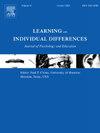Self-regulated learning at the workplace: State, trait, or development?
IF 3.8
1区 心理学
Q1 PSYCHOLOGY, EDUCATIONAL
引用次数: 0
Abstract
Background
Health sciences students often encounter challenges when they begin learning and practicing in the workplace. Various research approaches and interventions have been developed to facilitate self-regulated learning in this context. To determine the most effective approach, a thorough understanding of the stability and variability of self-regulated learning in the workplace is necessary.
Aim
This study analyzed the stable trait, autoregressive trait, and time-varying state components of self-regulated learning in the workplace.
Sample
The sample comprised 188 undergraduates who were learning at a medical workplace for the first time and rotating weekly between various settings.
Methods
Undergraduates completed a diary on 37 aspects of self-regulated learning for a duration of 10 weeks. Data were analyzed using STARTS models.
Results
The aggregate results showed that 28 % of the total variance in self-regulated learning in the workplace was accounted for by the stable trait component, 22 % by the autoregressive trait component, and 50 % by the time-varying state component. These component ratios vary across different areas (cognition, motivation, emotion, and context) and levels (learning process level and metalevel) of self-regulated learning.
Conclusions
To enhance health sciences students' self-regulated learning in the workplace, it is recommended to focus on research and interventions to provide situation-specific supportive framework conditions while acknowledging individual differences and considering phase-specific interventions. Further research is required to determine whether these findings can be applied to other rotational intervals and subject areas.
求助全文
约1分钟内获得全文
求助全文
来源期刊

Learning and Individual Differences
PSYCHOLOGY, EDUCATIONAL-
CiteScore
6.60
自引率
2.80%
发文量
86
期刊介绍:
Learning and Individual Differences is a research journal devoted to publishing articles of individual differences as they relate to learning within an educational context. The Journal focuses on original empirical studies of high theoretical and methodological rigor that that make a substantial scientific contribution. Learning and Individual Differences publishes original research. Manuscripts should be no longer than 7500 words of primary text (not including tables, figures, references).
 求助内容:
求助内容: 应助结果提醒方式:
应助结果提醒方式:


